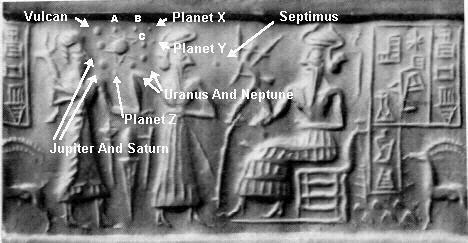
Figure 1. The Akkadian Seal - Catalogue Number VA 243 In Berlin's Vorderasiatische Museum. © Sitchin 12th Planet
Madam Blavatsky postulated this solar body's existence around 1877 and named it 'Vulcan'. Astronomer Forbes found three of this body's orbital parameters in 1880. This work details its mass and orbital parameters (found in 2002-2004) and they matched Forbes' values within measurement error. Vulcan casts objects from Kuiper Belt into 3:2 resonate Sun grazing orbits (~3313 year) where they break up forming meteor or comet swarms. Fragments from these swarms sometimes hit Earth causing significant weather changes. Paleo-climatological data from more than thirty related impacts have been identified from tree ring and ice core data spanning the past 15,000 years. This data, added to others, lead to 4 different measurements independently verifying Vulcan’s orbital period (of ~4969 years).
The ancients were aware of this Jovian like body. Moreover, it appears that some well informed members of the astronomical community were aware of this ancient knowledge. This, combined it with intelligence gained from extra- terrestrial aliens contacts, suggested that an ultra-tiny brown dwarf star existed in our outer solar system. The Pioneer, Voyager, IRAS satellite and possibly even the Hubble space telescope were constructed to locate and observe this body.
Venus may have been hit by just such a large fragment only a few million years ago. The magnitude of the impact had the result that its surface was melted and reformed. This event offers support for Christ's prediction that a similar catastrophe could happen to Earth. But before that happens, Earth may be subjected to another impact (before ~2160 AD) starting a new Ice Age. After that, (~3800 AD) Earth and a diminished and weakened mankind may suffer a similar fate, making Earth uninhabitable. The video below offers a realistic scenario depicting how this final event could unfold.
Vedic Prophecies have long held that the Sun has a 'dark companion' and the Bible Code, written about 3200 years, ago not only contains references to it by name but associates it with comet/asteroid impacts. MadamBlavatsky even refers to how its presence astrologically influences avatars like Christ and Buddha.
A Jovian sized Vulcan was known to the ancient Akkadians of the third millennium B.C. Not only was it known, but they also knew of planets Neptune (that cannot be seen with the naked eye) and the barely visible Uranus. Figure 1 shows the Akkadian seal containing an image of Vulcan and the four Jovian planets, Jupiter, Saturn, Uranus and Neptune (courtesy of the seated god Ea - a Cenos astronaut from the Proxima Centauri star system). Note the size of Vulcan is between that of Saturn and Jupiter. Almost anyone can envision the Sun and these five solar bodies depicted in the Akkadian Seal.

Figure 2 shows a mathematical fit of the Sun and Jovian's diameters as measured from the Akkadian Seal vs. their known masses. The quality of the fit (0.997) of the straight line proves, beyond any doubt, that the 'ancients' were both aware of these planets and their relative masses compared to the Sun's. Further, it also implies that there is another Jovian like planet in our solar system (our Vulcan) of 141 +/-35 Earth masses. Similar Vulcan masses have been deduced by other means; 166 Earth mass and [333,000(Sun mass in Earth masses)] X [ 0.35 Earth Orbit radius from the Sun (Bary Center)]/[ 447.6 - 0.35] = 261 Earth Mass.
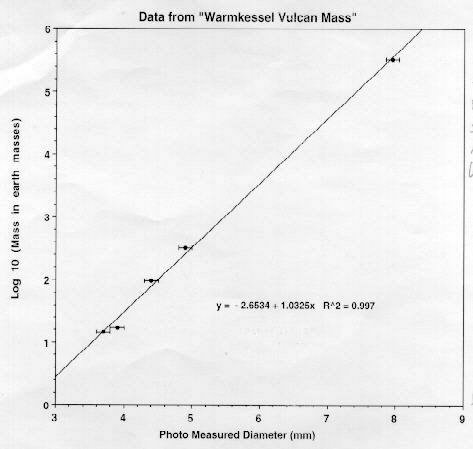
Newton's 'Philosophia Naturalis Principia Mathematica' published 5 July 1687 offered the first modern day estimates of relative masses for the known giant planets, the Earth and the Sun. So one must wonder where the ancient Akkadians got the concept of mass depicted on the Seal. Further, the inclusion of Uranus and Neptune on the Seal suggests that the source of this knowledge must be someone else. Most likely, this information came from extra-terrestrial alien contacts because only they would have the technology to deduce this information at that time.
There are more recent references to this dark companion from those "extra-
terrestrial alien" sources.
Dr. J. Allen Hynek (Astronomer):
Civilian scientific consultant to the U.S. Air Force (1948/49-1969) i.e. 20
years. He began as a debunker of UFO sightings, however he discovered there was
what he felt were a significant percentage of these reports which he could not
explain. He became convinced they deserved further study by the scientific
community.

A well circulated, but unpublished, case occurred on 6 Oct. 1974. The individual was invited on-board a saucer. Figure 3 is the Invitee's description of the alien's interpretation of our alphabet and a description of our solar system. Our planetary symbols were employed by the aliens, but they may have been deduced years before they left on their long journey to our solar system. The first three alien symbols, 12V, translates to G2V. The Sun's recognized astronomical characterization is that of a G2 main sequence spectral class V star.
Three other solar objects are indicated, one above and one below the string of planets and a final one at the end. Two (phi and *) appear to be dwarf planets respectively above and below the ecliptic plane. The 'above' one these may be Eris (dwarf planet) - orbital inclination 44.040o and the other, (2012 VP113, also known by its nickname "Biden") - orbital inclination 24.110o, is another dwarf planet candidate. Both objects have been 'captured' by the Sun. The I symbol denotes a Z type brown dwarf star. The ET aliens seem to have known that we humans would classify this body as a 'brown dwarf' before we had officially established (or suggested) that classification. Moreover, the Z type brown dwarf classification is still not official, but it is 'reserved' for those brown dwarf stars colder than Y type brown dwarf stars. Jill Tarter (known for SETI research} coined the term "brown dwarf" in her PhD thesis while researching small-mass objects that fail to stably fuse hydrogen. Jill Tarter suggested the term "brown dwarf" in 1975 because "brown" is an approximate color of these substar objects. Only the detection of objects with orbits inclined more than 40 degrees from the plane of the solar system will clinch the case for the presence of extrasolar planets in our backyard.
The Invitee was also told that the asteroids (Maldek) resulted from an exploded planet, a view since popularized by a well known Naval Observatory astronomer.
It appears that someone in the government/NASA decided that a search for this distant planet or brown dwarf was a worthwhile undertaking.
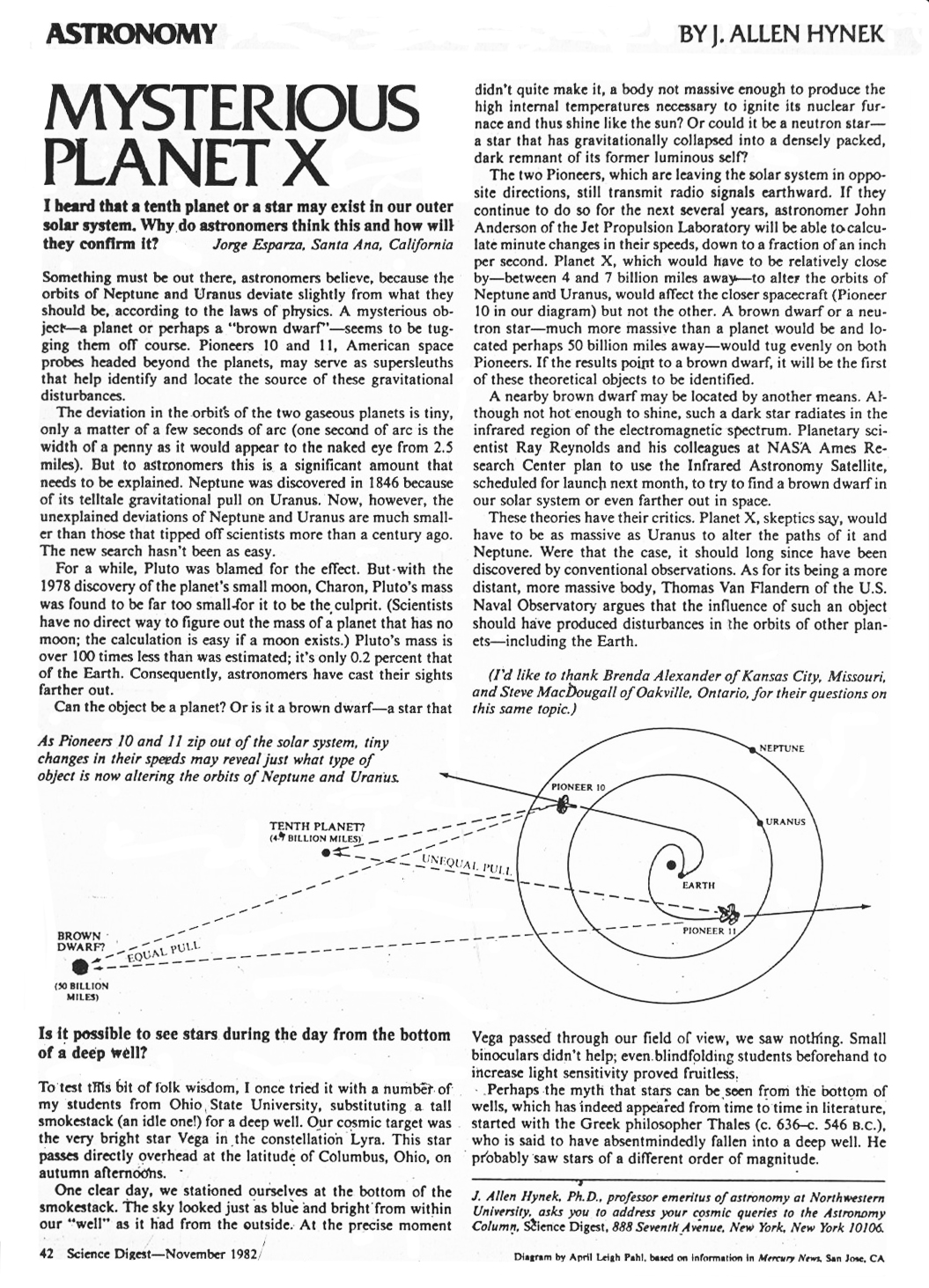
A21: Israeli NEWS Live Reports The Impending Asteroid Strike.
Military Insider (John Moore - Graduate of US military intelligence school in
1967) Shares His Knowledge Of Coming Disaster
Vulcan appears to influence the Earth's core magnetically when it passes
aphelion (and presumably perihelion
Analysis - Physical Data Impacting Candidate Vulcan Orbits
Notice:
A magnetic disturbance has been directly observed on a brown dwarf for the first time, showing that these objects behave more like stars than planets. They exhibit strong magnetic fields and possibly, like stars, interact with the discs of gas and dust that surround them in their youth.
Berdyugina led a team that used spectral data from Keck telescope observations of a brown dwarf 55 times the mass of Jupiter called LSR J1835+3259, about 18.5 light years away. The light was polarised in a way that revealed a local magnetic field even bigger than the strong ones that accompany sunspots.
Berdyugina says this is so strong because brown dwarfs are relatively dense compared to stars. The field could also have been detected because one of the dwarf’s magnetic poles may have been facing roughly in the direction of Earth when it was observed.
Vanishing magnetism
Over the course of two nights, the magnetic disturbance disappeared, but then one appeared on the other side of the brown dwarf. Berdyugina and her colleagues say that probably happened because the disturbance rotated out of and back into view, but they are not certain.
The coolest class Y dwarfs can have temperatures as low as 250 Kelvin (negative 23 degrees C).
But brown dwarfs don't just exhibit starlike convection currents, they also have pretty impressive magnetic fields. Case in point: A brown dwarf called LSR J1835+3259 was studied and found to be magnetically active, according to a September 2017 study published in the Astrophysical Journal. In fact, it's so active that it rivals our sun's magnetism.
What they found came as a surprise: As the object rotated, a powerful magnetic region came into view, more powerful than the magnetic fields associated with sunspots that we observe on the sun. Sunspots are magnetically active regions that can trigger coronal mass ejections, solar flares and produce powerful streams of solar wind — all of which can generate powerful geomagnetic storms on Earth.
In an interview with New Scientist, the researchers point out that LSR J1835+3259 is very young (approximately 20 million years old) and the powerful magnetic field could be interacting with the object's protoplanetary disk (if it has one). But if this active magnetic region is long-lasting and representative of its global magnetic field, LSR J1835+3259 is way more "star-like" than we give brown dwarfs credit for.
So rather than calling brown dwarfs "failed stars," perhaps we should call them overachieving planets or magneto-dwarfs.
Not only were the Pioneers sent out to try to detect its gravitational influences on the spacecraft, but the Voyagers were sent out to refine its location.
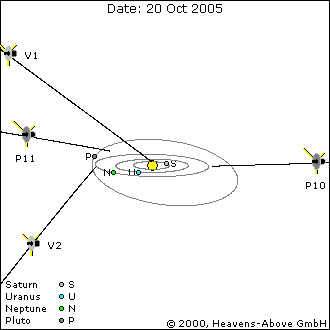
Figure 5 shows that the Voyager probes (launched 1977) bracket an object (a Brown Dwarf?) roughly located by the Pioneer probes (launched 1972 - 73). Table 1 shows that one of the first reported IRAS (Infrared Astronomical Survey) Satellite objects, IRAS 1732+239 - thought to be our Vulcan, is in the nominal direction of Pioneer 11. Pioneer 11's radio transmitter (conveniently?) 'failed' when it was about the distance of Pluto's perigee (30 AU).
| Probe/Target | Rt. Asc. | Dec. | Range | Helio. Long. | Helio. Dec. |
|---|---|---|---|---|---|
| Pioneer 10 | 5.057 hrs | 25.83 deg. | 89 AU | 77.20 deg. | 3.01 deg. |
| Pioneer 11 | 18.596 hrs | -8.57 deg. | 70 AU | 279.06 deg. | 14.59 deg. |
| Voyager 1 | 17.076 hrs | 12.13 deg. | 97 AU | 253.35 deg. | 34.78 deg. |
| IRAS 1732+239 | 17.5476 hrs | 23.9433 deg. | 448** AU | 260.78 deg. | 47.17 deg. |
| Voyager 2 | 19.680 hrs | -52.26 deg. | 78 AU | 287.50 deg. | -30.35 deg. |
Figure 6 shows a 1983 NEWS report of a heavenly body almost as large as Jupiter, or possibly a protostar (brown dwarf) discovered 50 billion miles away.
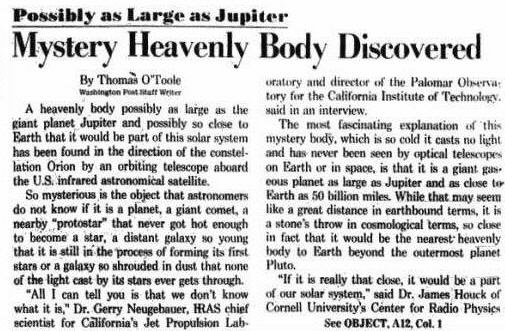
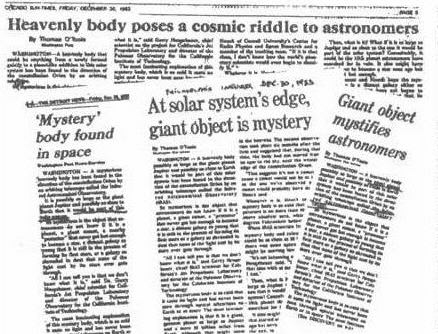
Figure 6. A NEWS Reports Of A Jovian Sized Planet Being Found.
The object may have been IRAS Object 1732+239, one of the first nine objects found by the IRAS Satellite, six of which were quickly resolved. The resolution of the other two IRAS objects that were initially unknown (1703+049 and 1712+100) appear to have been accomplished later. The image for IRAS OBJECT 1732+239 showed multiple objects in the error box. Notice in Figure 6 that there may have been an attempt to 'off-ramp' others who may be interested in this object by claiming that it was in the constellation Orion.
Sitchin noticed a fifth Jovian like object (our Vulcan) on the Akkadian seal, but Hynek (and the 1974 aliens) considered it to be a brown dwarf like star. The IRAS satellite could detect nominal range and possible motion of a ~50 billion mile distant infrared object in our solar system. That is why multiple acquisitions of an IRAS object were required to confirm its possible existence in our solar system. A comet would be too small to be detected unless it were truly a giant planet sized one. And a dust shrouded galaxy would not move, but its infrared output could possibly vary thus giving a false reading. The NEWS article proves that the IRAS team was at least aware of the fifth Jovian sized planet depicted on the (alien derived?) Akkadian Seal as well as the alien concept that it could be an un-ignited stellar object (e.g. a ultra tiny brown dwarf). This also proves that a select group of astronomers were also privy to extra-terrestrial alien intelligence concerning the structure of our solar system. Our ASTRO- METRICS concept considers it to be the binary companion of our Sun and the instrument necessary to form our planets. But this does not prove that they discovered such an object in our outer solar system.
Sitchin noticed that some astronomical object (in a comet like orbit) appeared in the sky's of Earth several thousand years ago and assumed it was this large Jupiter like object. But such a passage would perturb the orbits of the inner planets, likely even ejecting them. Given the circular nature of most of the terrestrial planets, that clearly has not happen. But what astronomers have long known is that an icy comet impact may have caused Noah's flood (first suggested by Sir Isaac Newton's assistant, William Whiston)
Our Obsession With Hidden Planets Didn't Start With Planet Nine - June 8, 2018
"In the early 1880s, astronomers looking for evidence of a ninth planet noticed two comets, 1862 III and 1889 III, whose orbital paths appeared to show the invisible gravitational influence of a trans-Neptunian planet, which might have stretched their orbits into ellipses. Astronomer George Forbes studied the orbits of several more comets and calculated that it would take not just one but two hidden planets to shepherd the comets onto their observed orbital paths. The masses and orbits Forbes predicted actually sound a lot like an early version of the Planet Nine that astronomers are currently searching for."
We believe the brown dwarf star depicted in the Figure 4's Science Digest article to be Madam Blavatsky's Vulcan predicted circa 1877. Her description of it being "The Forge Of The Avatars" (like Christ or Buddha) or "The Solar Logos" requires Vulcan to be a star like body. Astrologer Max Heindel described how the Moon plays a similar function for humans. We have regarded the Earth/Moon system to be a double planet analogous to the Sun/Vulcan system. Thus, there is a mechanism in place to deduced Vulcan's orbital parameters and they are shown in Table 2:
| Parameter | Value | Max. Error | Min. 2 Sigma Error | Forbes'(1880)* 1 Sigma Error |
|---|---|---|---|---|
| Period (years) | 4969.0 | +30.4/- 24.3 | +/- 11.5 | 5000 +/- (200) |
| Orbital Eccentricity | 0.537 | +0.088/-0.035 | +/- 0.0085 | not cal. |
| Orbital Inclination | 48.44o | +3.12o/-9.05o | +/- 0.23o | 45o +/- (3.6o) |
| Longitude of the Ascending Node | 189.0o | +/- 1.3o | +/- 1.3o | 185o +/- (14o) |
| Argument Of Perihelion | 257.8o | +6.11o/-13.47o | +/- 0.90o | not cal. |
| Time of Aphelion (years) ** | 1970 AD | +/- 1.0 | +/- 1.0 | not cal. |
Astronomer Forbes (1880) used comets aphelia to predict a similar orbit. Forbes' claimed his 5000 year period suggested a 300 AU semi major axis that, in turn, implied a +/- (200) year uncertainty (4% relative error) in his orbital period. Assuming this error is reflected in his other two orbital parameters, a +/- (14o) uncertainty is in the Longitude of the Ascending Node and a +/- (3.6o) uncertainty in the Orbital Inclination are implied (if a retrograde orbit is ruled out). The probability that the apparent correlation of Vulcan's and Forbes' orbits is fortuitous is given by:
31/5000 X (3.44o/90o)X (4.0o/360o) = 0.00000263
There is about one chance in 380000 that these two orbits are not related. Therefore, it is highly likely that Forbe's orbit and Vulcan's orbit are describing the orbit of the same solar body.
Vulcan's Aphelion is at 41.6 billion miles (448 AU). Stars pass within 2000 AU from the Sun over the solar system's lifetime and they would eject planets more distant than Hynek's 50 billion miles (537.6 AU). Notice that two of the vectors determining Vulcan's orbital plane were deduced using Blavatsky's theosophy and an exotic form of the Chinese Tzu Wei astrology. These defined Vulcan's location in 413 BC and 33 AD. A third vector is defined by the IRAS point 1732+239 and defined Vulcan's 1983 location. These three vectors are directly associated with Vulcan and not indirectly to it as some small Kuiper belt objects do.
The Probability (P) of these three vectors fortuitously falling in the same orbit plane inclination with such a tiny angular uncertainty as Vulcan's is about one chance in 250 [P = 0.6%]. Put another way, there are about 249 chances out of 250 [P = 99.6%] that the body described in Table 2 is Blavatsky's 'Vulcan'. Vulcan/Planet Nine's existence was either missed or suppressed with the NEWS media releases suggesting the latter (Mystery Heavenly Body Perhaps As Big As Jupiter - O'Toole). The probability of IRAS point 1732+239 fortuitously lying in Vulcan's orbit plane to within +/- 0.23o (~two sigma) is:(0.46 deg x 360 deg)/( 12.57 X 3282.8 sq. deg. in a sphere) = 165.6 sq. deg./41264.8 sq. deg. = 0.004This Vulcan/Planet Nine correlation indicates the following:
The reclassification of other minor bodies as 'dwarf planets' makes one wonder if some could be the planets of a brown dwarf star. Bodies like Biden (2012 VP113), Eris (2003 UB313) and Pluto do show a 'planet like' relationship with Vulcan and Scatter Disc Objects like 2000 CR105 2001 FP185 and 2002 GB32 appear to be in a 3:2 resonance with it. This association is especially true of Eris since its orbital inclination is about 44o (a few degrees less than Vulcan's). Kenyon and Bromley (originally posted by Harvard) say that only the detection of objects with orbits inclined 40o or more from the plane of the ecliptic will prove the existence of 'alien' planetoids. This may be why the existence of Eris was kept secret.
Vulcan draws in Kuiper belt objects that fragment into meteor or comet swarms if they pass near the Sun. Figure 7 shows how these Vulcan related swarms move about the Sun.
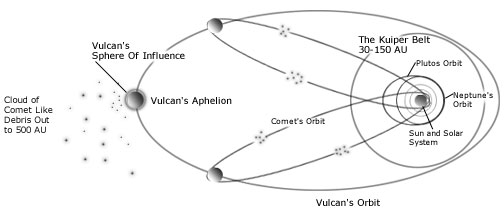
The comet impact threat was known to the Egyptians well before the time of Christ. However bot Christ and Sir Fred Hoyle probably offer the most outstanding warnings. The Bible is full of warnings of comet or asteroid impacts, especially from Christ as found in the New Testament. Clear text Bible predictions speculating on impacts have been interpreted as follows:
A few million years ago, such an event happened to Venus. See: What Would Happen If A Massive Oort Cloud Comet Stikes Earth? Answer: Venus"Starting at the end and work forwards, the last cataclysmic event is when the Earth is renovated by fire. It is discussed in 2 Peter 3:5-13 and Revelation 20:7-15. The Earth is turned into a sea of fire and lava. There are no longer any oceans. This event could be cause by a large impactor 100- 200 miles in diameter. The Meteorite Collision video offers a good illustration of such an event.
Before that happens there will be a millennium, a thousand years, of peace. Revelation 20:1-6 - God made a promise to the Jewish people, during this time he will begin to fulfill it. Before that there is a Great Tribulation. This event is discussed in Matthew 24:21, Revelation 8:5-13, Revelation 6:12-17, Revelation 16:17-21 and Revelation 18:8-10,21 to name a few. The damage falls in line with the damage that would be created from an impactor in the 2 - 3 mile diameter range. Across many cultures, dragons have been symbolic of comets. As a result, if the damage during the Great Tribulation, was done by an impactor, it is somewhat natural to believe that the impactor would be a comet."
"After several million years, the planet would cool down and a crust would form. The crust creates an insulation barrier between the hot magma and the atmosphere. Surface temperatures would drop below 1,000o F. The average temperature at the surface of Venus is 865o F."
The recently deceased Royal Astronomer, Sir Fred Hoyle, has likewise warned us of such disasters. He proposed that meteors (or comets) strikes are responsible for both the rapid onset and termination of Ice Ages as well as the variations of global ice levels found in the Pleistocene. This is exactly what a 2 to 3 mile in diameter impactor would do. Specifically, Hoyle said:
"Together with disease, the next ice age ranks as the biggest danger to which we as individuals are exposed. The next ice age is not a specific problem of the distant future. The causative agent, the strike of a giant meteorite, could happen at any time.
The risk of the next ice age is not just the biggest of the risks that we run. It is a risk that would hopelessly compromise the future. Besides wiping out a considerable fraction of those now alive, it would leave a wan, grey future from which the survivors and their descendants could do nothing to escape. It would be a condition that might last 50,000 years or more, a future in which the prospects for mankind would be much less favourable than they are today. This is why our modern generation must take action to avoid catastrophe, an ultimate catastrophe besides which the problems that concern people, media and governments from day to day are quite trivial."
Mother Shipton, Nostradamus, the Biblical Zechariah and a host of minor prophets have likewise forecast impending comet impacts. What's worse, Nostradamus' predictions end in the year 3797 AD implying that mankind likewise ends then. Apparently, should the impact of a giant meteorite or comet happen before 2160, the population of the Earth would be so decimated that it would be unable to prepare for the 'Venus like' cataclysmic event predicted by Christ.
Current warnings have even come from what appears to be extraterrestrial alien sources as late as 1995. Figure 8 contains an image of Crop Circle T367. Note that the planets depict a planetary positions that seem to relate to late February 2007 and that the Earth appears missing from its orbit seeming implying that it will be destroyed by one of the objects labeled 2 - 5 (comets or meteors?). Such objects would not physically destroy Earth, but they may just cause a major change to its habitually for mankind.

It is interesting that in this crop circle, the Sun is offset from a cleared central region. The offset is in the opposite direction of IRAS 1732+239. Considering Vulcan to be near aphelion, 448 AU, simple mathematical projection implies it is about half the mass of Jupiter - 160 Earth masses. Vulcan's high inclination is not alluded to here implying that this crop circle is to be considered a 'cartoon' and not a 'photograph' of the physical situation. Four threat periods per year have been identified for the years after 2007.
Humans became sentient about 55,655 to 55,680 BC near an Ice Age thermal minimum. Then it got colder. The climate did not begin to warm up until 15,000 years ago.
Table 3 illustrates that Earth has been the victim of many impacts in the recent past. Major comet/meteorite impacts cause significant weather changes and cause the collapse of civilizations. The most notable events are Noah's Great Flood (~3,195 BC) and the Atlantis disaster (~9,703 BC). The comets/meteorites may not be visible until they hit the atmosphere as their volatile ices may have been cooked away during their many passes around the Sun.
Comet impact generated climate changes offer indirect evidence that verifies Vulcan's theoretical period. The 3:2 resonance means an interval of two theoretical Vulcan (4969 year) periods is required to maintain the same celestial geometry's impact on the swarms otherwise Vulcan's gravitational force slightly changes the swarm's period. The 9938 year interval has been measured to be accurate to within a year for two A Swarm Cluster 1 (A:Cl-1) impact events. These are spaced exactly two Vulcan periods apart. The measured value is found to be 9939 years. However, the second event was a small one as the major meteorite/comet appears to have hit during the earlier event. A similar value of 9942 years is measured for the B:Cl-1 cluster that initiated the Younger Dryas weather change event.
Indirect evidence is also available from the orbital period of comet 2000 CR105. CR105 is a member of an exclusive club containing only a few distant comets whose perihelion's (far-points) are too far away from Neptune to be influenced by it or any other commonly know solar planet. CR105 orbit offers the elusive astronomical evidence that is tantamount to revealing Vulcan's existence. Including Vulcan's mass and orbit, CR105's average period over three orbital revolutions is 3307.6 years.
Multiplying CR105 average period by 3/2 gives Vulcan's period of 4961.4 years, only 7.6 years off the theoretical 4969 year value. Moreover, other distant objects, like 2001 FP185 (3433.7 years) and 2002 GB332 (3234.2 years), appear to be in a similar 3:2 resonance and 1999 DP8 (1246 years) in a 4:1 resonance with Vulcan.
Weather changes at nominal ten thousand year intervals induced by impacts of fragments from the A:Cl-1 and the B:Cl-1e swarms' cluster along with the estimate of Forbe's planet's period and the CR105's average orbital period offer a ways to verify Vulcan's orbital period. These three different means using four different independent measurements can be statistically combined. Thus, there are four independent measurements of Vulcan's orbital period resulting in:
Vulcan's Combined Measured Period = 4969.3 years +/- 8.14 (one sigma) years.
Vulcan's theoretical period obtained from the Blavatsky's Theosophy is:
If Vulcan is at IRAS point 1732+239:
Vulcan's Theoretical Period = 4969.0 years +/- 5.7 (one sigma) years.
If Vulcan is nearby (e.g a typo was made recording the IRAS point 1732+239):
[Vulcan's Theoretical Period = 4972.0 years +/- 27.35 (one sigma) years.]
It is statistically certain that the combined measured periods is within 97.6% of Vulcan's theoretical period if Vulcan is at the IRAS point employed, and 92.4% if it is not. Any probability > 40% means that the two physical quantities are related.
There have been at least 36 weather changing impact events over the last 15 thousand years. A recent one, around 2345 BC, claimed more than half the population of the world. Even worse catastrophes may have occurred earlier than three thousand BC.
| Observed Date Years Ago (b2k) |
Swarm A, A' B, B' or C | Cluster Delta* |
Cluster Pre Post Aphelion ** | Event | |
|---|---|---|---|---|---|
|
289, 320 510 | B':Cl-2 B':Cl-1 | 237 - 278 | - | Small Strikes 1680 - 1700 AD? Mahuika Crater, New Zealand tsunami 1422 or 43 | |
|
882 1120 | C:Cl-2 C:Cl-1 | 238 | - | Water, China Strike Tree Ring Data 880 +/-5 AD | |
| 1464
1584 1764 | A:Cl-2 Volcanic A:Cl-1 | 300 - - | 580 - 666 | (Ice Core data Sulfated)
Volcano or Comet dust - | |
| 2044 | - | - | - | Caesar's Comet - Comet dust | |
| 2207 2430 | A':Cl-2 A':Cl-1 | 223 | - | Volcano or Comet dust Volcano or Comet dust | |
| 2785 to 2838
3159 | B:Cl-1e B:Cl-1? | 374 - 321 | 843 - 790 740 | Global Climatic Boundary ~800 BC Exodus?/Bronze Age Collapse | |
| 3370 | - | - | - | Santorini Volcano | |
| 3582 | ? | - | - | Joshua Impact Event 1582 BC? | |
| 3628
3899 | B':Cl-2 B':Cl-1 | 271 | - | Comet - Deucalion Flood Comet - ? | |
| 4020 | - | - | - | Volcanic dust | |
| 4195?
4344 - 54 | C:Cl-2 C:Cl-1 | 149 | - | - Global Comet Event | |
| 4742 4870 5195 - 5201 | A:Cl-2? A:Cl-2 A:Cl-1 | - 325 - | 808 | Volcanic dust
Sodom/Gomorrah Sulfur (Biblical 4757 to 4763 YA) Tsunami 2870 BC Noah's Flood To Sodom Biblical Separation 438 yr. | |
| 5550
| A':Cl-2 | - | - | Oldest Societies 3500 - 3600 BC | |
| 6370 | B-Cl-2? | - | 630 | Tree Ring Data 4370 BC | |
| 7000 | B':Cl-2? | - | - | Water Strike/Black Sea Flood | |
| 7600 | C:Cl-2 | - | - | Cold Dry Period | |
| 8060
8236 +/- 47 8550 | A:Cl-2? A:Cl-2 A:Cl-1 | - 314 - | - | Old Data Maybe Invalid Volcanism (8.2 ka cold event) Global Climate Change | |
| 9350 +/- 250? 9796 +/- 20(or 1) 9945 +/- 20(or 1?) | B: Cl-2 B:Cl-1e B:Cl-1a | - | 997 | Global Climatic Boundary - Old Data? Strikes/Volcanism (NBI); 7946 BC, 7907 BC, 7878 BC, 7812 BC, 7797 BC (B:C1-1a) 39yr (B:C1-1b) 29 yr (B:C1-1c) 66 yr (B:C1-1d) 15 yr (B:C1-1e) | |
| 10347 +/- 89 | B':Cl-2? | - | - | Saksunarvatn volcanic layer | |
| 10850 | C:Cl-2 | - | - | Global Climate Change | |
| 11320
11703 +/- 20(or 1?) | A:Cl-2 A:Cl-1 | 383 | 900 |
Two prominent warming peaks (within 11,800–10,800 B.P) are in the (GISP2) ice core data. Younger Dryas Exit. 9,704 BC Atlantis impact event. | |
| 12171 +/- 114 | A':Cl-2? | - | - | Vedde volcanic layer (Z1) | |
| (12747) 12896 +/- 138 | (B:Cl-1e) B:Cl-1a | - | 754 | (Hypothetical - Estimated From 9796 YA Values) Abrupt Onset of Younger Dryas In 1 Varve yr. | |
| 13650 14075 +/- 169 | B'Cl-2 B'Cl-1 | - | - | - - | |
| 14235 | C:Cl-2 | - | - | Huge pulse of freshwater drained from continental ice sheets ice core | |
| 14692 +/- 186 | A:Cl-2 | - | - | Bolling/Allerod starts, Goughs Cave (Cheddar) radiocarbon |
The climatic change data provided by the Center for Ice and Climate, offers data showing at least five major weather changes about ten thousand years ago. With the knowledge of Vulcan's period and the 3:2 resonance structure of the meteor/comet swarms, an accurate estimate can be made of when Earth is next at risk. These calculations imply that we are currently living in a time when dramatic weather changes could very rapidly occur - usually Global Cooling Events.
Related impacts/weather changes may already be underway. The 8 October 2009 Indonesian 10 meters wide meteor exploding in air with the force of 50,000 tons of TNT could be the first major strikes from the returning first cluster of the B-swarm. Significant weather changes have appeared since then.
In 2010, comet fragment explosions may have caused great concern. The WISE Infra-red comet and asteroid detector that was launched in December 2009 was waiting for them. The WISE Infrared Space Telescope is:
"really good at finding the darkest asteroids and comets" like "dark asteroids that may be former comets that have long since had all the ice vaporized from their exteriors, leaving them with inactive surfaces that no longer shed dust to produce tails."WISE's mission ended late October 2010. Dark comets warmed by the Sun results in an increase in their visibility for 5 months (~2.8 AU) before they threaten Earth. Comets near or beyond Jupiter's orbit are generally stable, as water ice is unaffected by the Sun's warmth beyond about 5 AU. Note that pure, clean, white snow or ice is stable as far in as 2.7 AU, in the middle of the Asteroid Belt, but normal comets have significant quantities of dust and dark materials such as hydrocarbons which increase the absorption of solar radiation.
There was concern that the mid November 2010 comet fragment (e.g. meteor)
atmospheric detonations over the North Atlantic and Chinese landmass could have
lead to much colder global winters. These fragments are thought to have come
from space debris that first grazed Earth circa 5 to 7 September, impacting Colombia and Brazil. The impacts of
these meteorites apparently injected enough cosmic dust in the atmosphere to
cause a Massive Cooling Event in northern Europe and southern China.
Just before the 12 November G20
meeting of that year, two Sub launched
ballistic missiles were launched off both the East and West Coast of the
USA.
They were soon determined to be of foreign origin, most likely Chinese. This
threat of nuclear war has continued with unpublicized, but verified, military
nuclear detonations in Syria (2013) and in Yemen (2015).